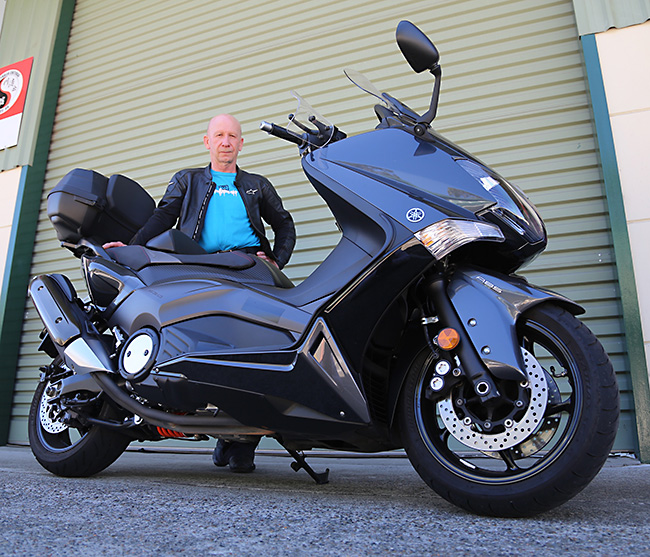Have you ever noticed how some bikes have fluffy poodle suspension, and others have twitchy greyhound set-ups?
SUSPENSION 101: If you haven’t, you probably think tyres are black round things that annoyingly, have to be replaced to pass rego. I can say that without fear of retort, because if that’s you; you would have stopped reading by now.
It’s always intrigued me how motorcycle suspension can look so simple, yet be so fiendishly difficult to get working well in all conditions. This is the Holy Grail of suspension tuning, and as it turns out, is never achieved. That’s why the word ‘compromise’ gets used a lot. Since perfection will always be illusive, what can you do? Quite a bit as it turns out, some of it inexpensive, some of it… well let’s just say gold plating never comes cheap.
Most suspension articles tend to get very technical. I’m not going to do that, as I’m not a suspension Guru. Luckily, I know one or two. Suspension is a huge field, and there have literally… been books written about it. If you really want to get into it, you’ll need to read some of these and your brain is going to get sore. I’m going to take a different tack and consider what suspension is trying to do, and go from there. If you understand what you’re trying to achieve, you should be able to evaluate if changes are moving you in the right direction.
Ok, let’s get to it…

Your shocks are primarily trying to achieve chassis stability in a wide range of circumstances. Two things need to happen for this. First, and by far the most important, is to keep the tyre tracking the road surface. Things turn to poo very quickly if suspension can’t manage this. The second thing is a little tricker to understand, that being maintenance of constant ride height. It’s a bit different for racers which I won’t get into, but the principle is the same. Why is this so important? To explain this, I briefly have to shift into ‘James May’ mode, sorry.
Consider the front forks. These are set at a very specific angle in relation to the road. This angle determines the rate of turn for any given steering input to the handle bars. Cruisers have a shallow rake (steering angle) and turn slowly, dirt bikes have very steep rake and turn quickly. Even very small changes to this angle will noticeably affect how fast the bike turns. Fork angle will also change as the motorcycle chassis pitches back forth in response to braking and throttle inputs – as the suspension compresses and extends. The situation is further aggravated as bumps also compress and extend the suspension. As you ride through a bumpy corner, all of this movement results in a lot of small changes to the fork angle; and consequently, small changes to your rate of turn. It can be like having half a dozen invisible gremlins wrestling with you to control the bars. The bike will feel very nervous and not hold its line.
Correctly set up suspension reduces this… a lot. It does so by allowing the bike to recover its nominal ride height as optimally as possible. Obviously road conditions play a part in whether this needs to be slow, or quick.
Shock performance is particularly critical. As ride height stability is hugely improved with a good shock, both the back and front suspension feel is enhanced. It’s one of the best upgrades you can do to any bike.
Quiz Time…
Which is more important… springs or damping? If you answered damping, you would be wrong. If spring strength is incorrect, suspension loads can’t be absorbed, and the chassis will rise and fall excessively. No amount of fiddling with damping will make it right.
FYI: race bike set-up is mostly spring choice and preload, with a little bit of damping to fine tune the set up. The good news is: for riders between 80 and 100kg, OEM springs are usually in the ballpark. Short guys like me (could happily buy Dani Pedrosa’s old leathers) or big boppers will require a different set of springs.
Three things to remember
1. Think about suspension as the constant maintenance of ride height.
2. Correctly setting spring preload is paramount and the first place to start.
3. Preload and compression damping controls rate/speed of return to nominal ride height, not the amount.

Before we move on, there’s a common misconception about suspension that I think is important to look at. Many think fast riding requires hard suspension. True enough on a closed circuit, totally wrong for street riding.
Track suspension set-up is a very precise affair, for a sprint involving 14 or so relatively smooth corners.
Street set-up is more general in nature, as all types of corners and surfaces have to be dealt with. Keeping tyres planted on the road is paramount, a hard track set up is a barrier to this (take note riders of all coloured sportsbikes).
The key is keep it as soft as you can. Assuming correct springs are fitted, damping is set low, to allow fast wheel movement over bumps. How soft? well I go full soft as a starting point. This usually means the suspension wallows because of insufficient damping. The suspension is overshooting its normal ride height on return from a deflection.
From there I start to firm things up gradually, till the wallowing goes away in most situations. A bit of wallowing is okay; this approach gives a compliant ride, with maximum grip. The compromise is comfoarable.
The path to Enlightenment.
Now that you’ve read the four paragraphs above, and therefore completed your basic suspension Guru competency, it’s time for an action plan. This can be simple and cheap, or complex and expensive. I’d recommend the basic action plan below to all. How far you want to go after that, will be limited by your ability to withstand wallet pain.
Where to start?
It’s important to have spring preload set for the correct suspension sag. Sag is the amount of spring compression that occurs to support the weight of the bike, and then the rider. I could bang on for ages about this, but I think watching a YouTube video would be better. Search “setting motorcycle sag”.
Once you’re on top of that, changing fork (and possibly shock) oil will make a big difference. Why? Manufacturers are partial to saving a buck and using slightly lower quality oil over the course of the thousands of motorcycles coming off the assembly line is an easy way to do this. Most riders can’t tell the difference and/or don’t care. However, good suspension oil has some very specific qualities that OEM may not. These being: viscosity stability, antifoaming capability and slipperiness. The aim of good suspension oil is to provide damping stability over a wide range of conditions, with minimum internal friction. It does make a difference.

The sweet spot?
The next stage along the enlightenment path is the component upgrade. Usually a shock. I’d recommend not overcapitalising here. There’s not a lot of point putting $4,000 worth of suspension into $6,000 motorcycle (unless you really want to). Most manufacturers do entry-level shocks sprung and valved to suit a rider’s weight. Prices range from $800 to $1200. Combined with quality oil and correct spring preload in the forks, this set-up will come close enough in performance to the premium offerings. As a bonus, when the time comes to move on, you can possibly keep the shock for your next bike or sell it separately, and usually get back 40 per cent of what you paid for it! Bang for your buck, this approach is the top of the bell curve.

Gold plated suspension?
If you really want to go for it, there are some pretty tasty options. Several European manufacturers make some beautifully engineered parts; offering state of the art performance and lightest possible weight. I’m talking suspension porn here. However, even in this rarefied atmosphere, there are budget choices. For example: manufacturers often make fork inserts (replacing the internals, but keeping the outside shell), as well as complete fork assemblies. The inserts offer 95% of the performance, for half the price. That’s hard to go past.
Shocks get lighter, perform better, have more adjustment, and features as the price climbs. If you’re at this level, you probably have your own suspension Guru, and ideally, a lot of personal knowledge means you’re starting to become one.
Keep in mind that from here, getting closer to optimum performance requires serious knowledge from someone.

Who can help?
Any good bike mechanic should be able to improve your suspension’s performance. However, when it comes to suspension, expectations need to be managed. Like so many things in life, you can’t have champagne with a beer budget.
It is possible have a better beer. Your mechanic should be able to help you access it.
The next step is a suspension specialist. They will be able to get you to the next level, but remember they will act on the information you give them about your needs, the type of riding you do, and your riding abilities.
If you give them crap information, you will get a crap result.
There we have it, you’ve entered the world of continual compromise that is suspension. Did I mention, once you’ve travelled the path to suspension enlightenment, and owned a bike with quality boingers, you can never turn back.
Taking it further
Finally, if you want to do further study towards your Suspension Guru Degree. You will need to look at these subjects: Effect of fork rake and trail; Fork tube positioning in triple clamps; oil height in forks; effect of changing shock absorber length; effect of rear sprocket size; position of rear axle; angle of the swingarm; shim stack alteration; high and low speed compression adjustment; suspension fault analysis (indicated by tyre wear); choosing between soft springs with lots of preload, and hard springs with minimal preload; and so on…
Remember what I said about a books and a sore brain…
–Phil James



Be the first to comment